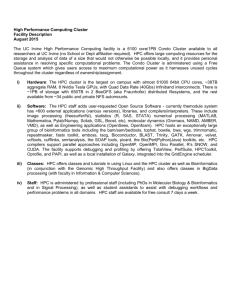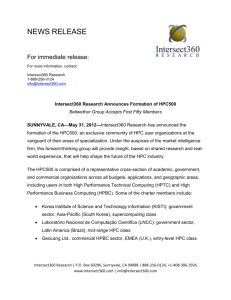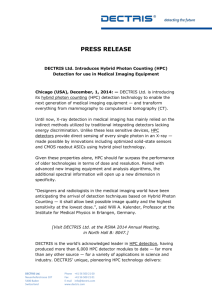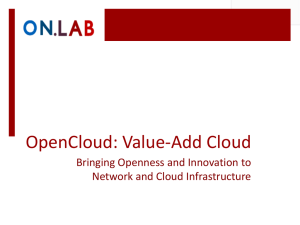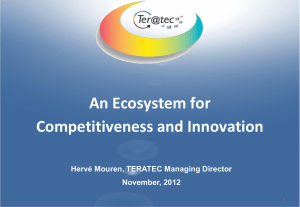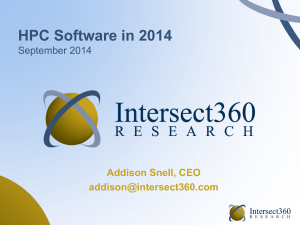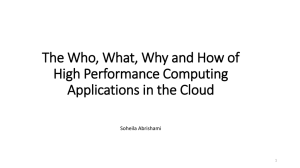Dr. Tryfon Chiotis,, HCP and Cloud Technologies in
advertisement
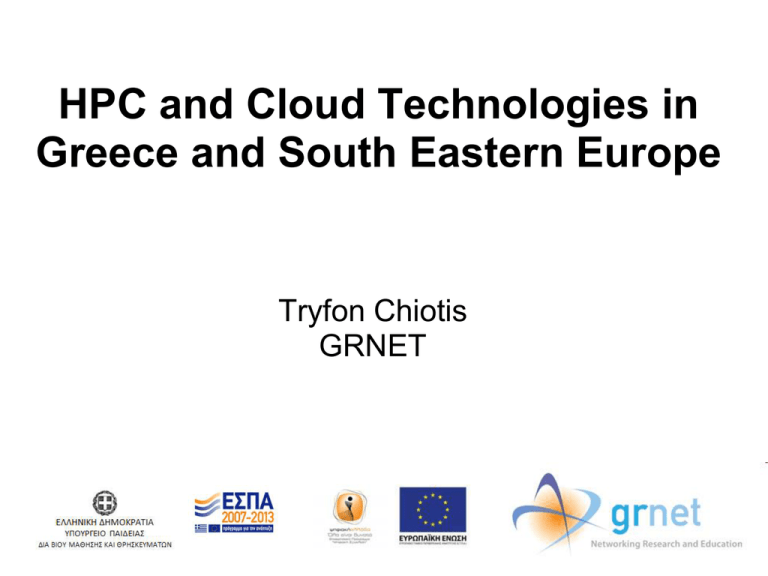
HPC and Cloud Technologies in Greece and South Eastern Europe Tryfon Chiotis GRNET GRNET • state-owned company (SA) under GSRT established in 1998 • provide advanced e-infrastructures/services to the Greek academic and research institutions: – National and international connectivity – Infrastructures/services (network, computing, storage) to the community • promotion and dissemination of ICT in the public and private sector 2 GRNET numbers: • • • • • • • > 100 universities, research centers, academic organizations > 15.000 schools > 1.000.000 users Dark fiber backbone (Nx10 Gbps) access 1 || 10 Gbps per institution International connectivity through GEANT network 3*10 Gbps Neutral point for the Greek Internet Exchange (GRIX) node – peering all Greek ISPs at 10Gbps each • GRID services • Storage Services – (e.g. Online Storage-Pithos, 50 or 100 GB/user–6500 users per day) • VPS VM provisioning (>400 VMs) & Public Cloud (~okeanos) • 2 DataCenters (NRC & Ministry of Education premises) 3 • 35 PoPs – 8410km fibers (IRU) • MANs Attiki & Thessaloniki • DF loops 33 cities • Single-mode fiber pair • 15-years IRUs • Availability >> 99% 4 Cloud Services • Virtual Private Servers (VPS) – Persistent volumes/longevity/non volatile VMs (RACKSPACE style) • Public Cloud Service ~okeanos (VM, volumes) – Short lived/volatile instances (high churn rate) Amazon (AWS) style • Online File Storage Service (Amazon S3 like) – Files, groups, REST API 5 Public Cloud Service ~okeanos • Deliver IaaS to GRNET’s customers • direct: IT depts of connected institutions • indirect: university students, researchers in academia • Other IaaS efforts (Amazon, Rackspace, Nimbula, Nebula, GoGrid etc) • • • • Amazon EC2 not an end-user service Need to develop custom UI, AAI layers Vendor lock-in Unsuitable for IT depts persistent, long-term servers, custom networking requirements • Nimbula Director offers similar functionality 6 GRNET and HPC - Invited by the Ministry of Development to submit a proposal which will support Greece’s participation in PRACE. - Goal is the development of a national HPC infrastructure that will join PRACE’s Tier-1 European infrastructure. - Budget 3.5 MEuro - Procurement and installation of HPC infrastructure - Operation and provision of support services Technical specs and target applications - Aiming for at least a ~150 Tflops supercomputing system - Petabyte level storage - Hosting in GRNET’s existing Datacenter - Support for a wide range of scientific disciplines: Biomedicince, Bioinformatics, Computational Engineering, Physics, Metoerology, Climatology, Seismology, Computational Chemistry etc. - Based on the results of the HellasHPC feasibility study - National survey among 29 academic and research institutes (summer 2010) - Collected requirements from 200 scientific applications developed by 162 research teams from various scientific domains High-Performance & Supercomputing: HP-SEE • 33 months 3,88 m€ project, 540MMs • 120 Tflops aggregate • 2 BlueGene machines • Larger procurements coming up • Close links to PRACE • Possibility of a joint Tier-1 centre • Balance of national and EC funds • Towards long-term sustainable European hierarchical model 10 Key results: HPC Initiatives • Support the setup of national HPC task forces or their incorporation in existing structures – National HPC initiatives guidelines provided – Governance, organizational, operational, training and dissemination details provided – D2.2: “National HPC task-force modeling and organizational guidelines” • Recommendations for HPC centers procurement provided – Legal, procedural, technical and planning – D2.1: “Procurement guidelines analysis” • Regional collaboration models in definition: Draft resource sharing MoU in place • Liaison with PRACE, other pan-European activities, and world-wide initiatives HP-SEE: Project Objectives • Objective 1 – Empowering multi-disciplinary virtual research communities • Objective 2 – Deploying integrated infrastructure for virtual research communities – Including a GEANT link to Southern Caucasus • Objective 3 – Policy development and stimulating regional inclusion in pan-European HPC trends • Objective 4 – Strengthening the regional and national human network Crucial for regional cooperation: policy development and political support • Project: South-East European Area for eInfrastructures • Area: "INFRA-2008-3.1: ERA-NET supporting cooperation for research infrastructures in all S&T fields“ • Start: 1 April 2009 • Duration: 36 months • Project type: Coordination and support action • Partnership: Ministry partners + eInfra partners programme manager partners • Core Objective: Develop and strengthen the coordination and cooperation of national eInfrastructures programmes in the region of SouthEast Europe. SEERA-EI: policy level collaboration • Establishing a communication platform for programme owners, at www.seera-ei.eu • Analysis of past and current eInfrastructure programmes and funding modalities • Joint training events; bilateral visits • Best Practices identification • National programme cookbook Common vision & strategy • Studies for joint operations centers, network (SEELight), HPC (regional ops centers) • Joint pilot call between Ministries in cloud computing • Join regional strategy and vision MoU 14 See more on: http://okeanos.grnet.gr
